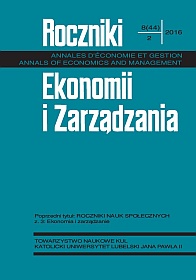The relationship between age and time of unemployment in Poland
Abstract
Discrimination on the grounds of age is an important problem of the Polish labor market. This problem is quite common. Stereotypical thinking and poor public awareness of older people’s potential do not support the proper use of human capital available on the Polish labor market. Depreciation of the elderly is noticeable in the recruitment processes as well as in the case of those who are working.
The aim of the article was to answer the question, what is the relationship between the age of the unemployed and the time that he or she needs to find a job. The research was carried out on all registered unemployed in Poland. The analysis concluded that unemployment duration tends to increase with age, and this regularity is not accidental in nature and was demonstrated on the basis of eight consecutive years. In addition, it was noted that differences in the structure of the unemployed in terms of time of unemployment are not constant and decrease with the transition to the next age groups.
References
Avolio B.J., Barrett G.V.: Effects of age stereotyping in a simulated interview, “Psychology and Aging” 1987, vol. 2, iss. 1, pp. 56-63.
Czyżewski B., Polcyn J.: Education quality and its drivers in rural areas of Poland, “Eastern European Countryside” 2016, no. 22, pp. 197-227.
Dembczyński K., Mądry K.: Sylwetka osób 50+ na zachodniopomorskim rynku pracy, [w:] Co z tą pracą? Pomorze Zachodnie w perspektywie interdyscyplinarnej i międzynarodowej, red. S. Flejterski, Szczecin: Wydawnictwo ZAPOL 2013.
Januszkiewicz K.: Rozwój zawodowy pracownika. Szanse i zagrożenia, Łódź: Wydawnictwo Uniwersytetu Łódzkiego 2009.
Kapitał ludzki w Polsce w 2010 r. Studia i analizy statystyczne, oprac. zbior. pod kier. J. Auksztola, Warszawa–Gdańsk: GUS, Urząd Statystyczny w Gdańsku 2012.
Kapitał ludzki w Polsce w 2011 r. Studia i analizy statystyczne, oprac. zbior. pod kier. J. Auksztola, Warszawa–Gdańsk: GUS, Urząd Statystyczny w Gdańsku 2013.
Kapitał ludzki w Polsce w 2012 r. Studia i analizy statystyczne, oprac. zbior. pod kier. J. Auksztola, Warszawa–Gdańsk: GUS, Urząd Statystyczny w Gdańsku 2014.
Kapitał ludzki w Polsce w 2014 r. Studia i analizy statystyczne, oprac. zbior. pod kier. J. Auksztola, Warszawa–Gdańsk: GUS, Urząd Statystyczny w Gdańsku 2015.
Mandrzejewska-Smól I.: Wiek i doświadczenie jako atrybuty działalności zawodowej, [w:] Praca człowieka w XXI wieku. Konteksty – wyzwania – zagrożenia, red. R. Gerlach, Bydgoszcz: Wydawnictwo Uniwersytetu Kazimierza Wielkiego 2008.
Miluska J.: Obrazy społeczne grup narażonych na dyskryminację. Uwarunkowania społeczno-demograficzne i psychologiczne, Poznań: Wydawnictwo Naukowe UAM 2008.
Polcyn J., Stępień S.: Efektywna organizacja dostarczania dóbr publicznych – na przykładzie sektora edukacji w Polsce, „Zeszyty Naukowe Wyższej Szkoły Ekonomiczno-Społecznej w Ostrołęce” 2016, nr 2(21), s. 266-280.
Zawadzki K.: Między pracą a emeryturą – benchmark europejski, [w:] Rynek pracy w Polsce w procesie integracji z Unią Europejską, red. Z. Wiśniewski, E. Dolny, Toruń: Wydawnictwo Naukowe Uniwersytetu Mikołaja Kopernika 2008.
Zeliaś A.: Metody statystyczne, Warszawa: PWE 2000.
Copyright (c) 2016 Roczniki Ekonomii i Zarządzania

This work is licensed under a Creative Commons Attribution-NonCommercial-NoDerivatives 4.0 International License.


